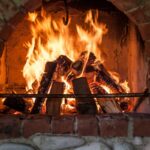Do you want to know how to tell if your damper is open or closed? Maybe you have had a new damper installed and want to know how to tell if it is open or not?

Or are you curious and want to know more? No matter the reason that brought you here, we have the answers for you!
Finding out if your damper is open or closed can be tricky, especially if it isn’t something you have had to do before.
You head online for some guidance but are met with page after page of confusing and conflicting information, leaving you unsure where to turn or who to trust.
But that is where we come in to save the day! The easiest way to tell if your damper is open or not is to perform a visual check, placing your head in the fireplace and looking up to see if the damper is open or closed.
We have more information on how to do this today, the other ways you can tell if your damper is open or closed, and everything else you need to know about dampers! Keep reading to find out more.
What Is A Damper?
Let’s start with a brief recap for anyone that needs it. A damper is a plate or valve that sits inside your chimney. The role of the damper is to regulate or stop the flow of air in a duct, chimney, VAV box, or any other air-handling equipment.
You can find it usually in the chimney of your fireplace and it will seal the chimney when your fire isn’t on. This way, it stops cold air from entering your home through your chimney, keeping your home nice and warm.
When the damper is open and there is a fire burning, it ensures that smoke leaves your house through your chimney.
If you were to light a fire and the damper was closed, the smoke would not be able to escape through the chimney, leaving you with a smoke-filled room and potential danger on your hands!
Now that we have established what a damper is, let’s move on to see how you can tell if it is open or closed.
How To Tell If A Damper Is Open Or Closed?
There are a few ways that you can tell if your damper is open or closed. Let’s take a look at these now to help you find a method that best suits you!
Visually Check
We touched on this earlier, but the best way to check if your damper is open or closed. Simply place your head in the fireplace and look up.
If you have a throat damper, it will block your vision above your head if it is closed. You should also be able to touch it and tell it that it is closed.
For top-mounted dampers, look up and see if you can spot any light at the top of your chimney flue. If there isn’t any visible daylight, the damper is closed! Of course, for this method to work, you will need to check your chimney during daylight hours.
While this is the quickest and easiest way to check, you need to be safe. Don’t check while your fire is lit and make sure that all wood and kindling has stopped burning before putting your head near the fireplace.
Feel For A Draft
Another option is to feel for a draft. If your damper is open, air will circulate in the chimney and you should be able to feel this cold air easily. Simply move your hand or face into the fireplace and feel for yourself!
If you can feel cold air, a slight breeze, or notice that the air is different from when the damper is closed, then it will be open!
While this is a great method, it isn’t perfect for top-mount dampers as the cold air stored in the chimney flue can make it seem as though the damper is open.
Check The Controls
You can also check the position of the controls to tell if the damper is open or closed. For this method to work, you will need to know the chimney and its controls, mainly the handle, cable, and rod. Check the position of these to see if the damper is open or closed.
If you aren’t sure of the controls or are checking a fireplace in a different home, it is best to ignore the controls and opt for one of the two methods we mentioned earlier.
When Should My Damper Be Open?
Your damper should be open when the fire is burning. You should open the damper before you start any fire to ensure that the smoke has a clear passage out of your home. Once your fire has gone out, the damper should remain open until all of the embers are out.
Your damper must remain open to ensure that smoke and the carbon monoxide that comes with it can leave the house! Once your embers are completely out you can close the damper and keep the cold air out of your home.
Take care when closing your damper after the fire has been lit. The damper can stay quite hot even after the embers have died out!
You might want to wear some thick leather gloves to protect your hands from the hot damper. Gloves will also prevent your hands from getting covered in soot that your damper will usually be caked in from the fire.
Final Thoughts
And there you have it, three methods that you can follow to check to see if your damper is open or closed! Whether you choose to check the airflow, visually inspect the damper, or use the controls, you can quickly tell if your damper is open or closed.
Don’t forget to take care when touching your damper to prevent injuring yourself on the hot handle!
- How To Open Chimney Flue - July 20, 2023
- Do Electric Fireplaces Use A Lot Of Electricity? - July 20, 2023
- How To Keep A Fire Going - July 20, 2023








